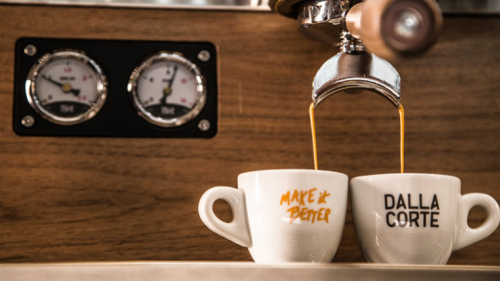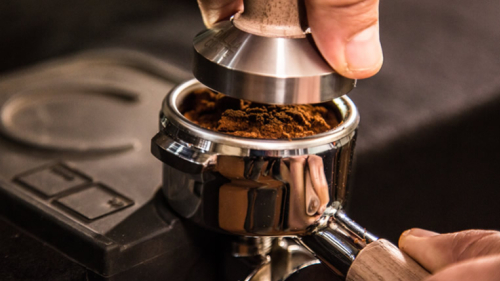Branding and customisation: How is espresso machine design evolving?
Dec 06, 2021
[source: Perfect Daily Grind]
Branding
and customisation: How is espresso machine design evolving?
The
espresso machine is often rightly considered the heart of the coffee shop: it drives beverage preparation, workflow,
and sales.
However, in
recent years, we’ve seen a focus on form as well as function. While technical
evolution is an ever-present focus for espresso machine manufacturers, design
and style are becoming more and more of a priority.
As espresso
machines have become increasingly modern in design, more and more coffee
businesses are putting them front and centre to both draw customers in and
showcase the latest innovations in technology.
So, how
have design and branding evolved in the espresso machine market? And where does
customisation fit into it? To learn more, I spoke with two coffee professionals
from Dalla Corte. Read on to find out what they told me.
A BRIEF
HISTORY OF ESPRESSO MACHINE DESIGN
Since the
first espresso machine patent was filed in 1884, machines have primarily been
focused on functionality over style and visual impact.
Angelo
Moriondo’s 19th century prototype featured two large boilers that produced both
water and steam, which meant it was a huge, bulky machine. Some 20 years later,
Desiderio Pavoni and Luigi Bezzerra introduced the first steam wand, which did
help reduce the size of the boilers.
At the turn
of the 20th century, however, art deco style machines became more common as the
market evolved. This design style was considered to be more luxurious – with
slick geometric patterns and a focus on craftsmanship.
A few
decades later, in the 1940s, the design was reinvented once more. Italian
coffee shop owner Achille Gaggia designed a lever-driven machine with chrome
fittings, which heralded a more modern look for the espresso machine. The lever
operation meant Gaggia could reduce the boiler size further, and increase the
maximum pressure to 10 bars.
Innovation
didn’t stop there, however. In the 1960s, Ernesto Valente had designed the
Faema E61. This machine included a motorised pump and heat exchanger that
helped pave the way for the design of automatic espresso machines. The E61’s
smaller size and stainless steel features cemented it as an iconic piece of
coffee equipment.
CUSTOMISATION,
VISUAL IDENTITY & THE CUSTOMER JOURNEY
It’s no
secret that the hospitality sector is competitive, and standing out is
important. As soon as customers walk through your doors, brands need to show
why they’re unique.
In recent
years, we’ve seen this reflected in the sheer amount of customisation made
available to coffee brands by espresso machine manufacturers.
Davide
Valenziano is the Head of Coffee at Dalla Corte. He says that to remain
competitive., businesses should focus on customising different aspects of the
consumer experience.
“The key
element in our work is to offer customers the best cup of espresso,” he says.
“As such, Dalla Corte has committed over the years to providing the barista
with the best technology possible.
“With Flow
Control, we have given baristas the opportunity of customising and recreating
recipes. With the Dalla Corte system, baristas can control [and customise]
every step of the customer’s coffee journey.”
Customising
or personalising the consumer experience makes customers more likely to return
to your business. According to research by Hubspot, some 80% of consumers are
more likely to purchase products when companies or brands offer personalised
experiences.
However, as
well as tailoring brewing variables and extraction profiles to offer unique
beverages and personalise the customer’s coffee journey, new espresso machines
also allow for a different kind of customisation: visual design.
A few years
ago, brands’ options were limited. They could choose between a limited range of
colours, and that was often it. Today, however, things are changing
manufacturers are offering a range of different ways to customise machines.
Valentina
Dalla Corte is the Product Line Manager for Dalla Corte. She explains that
design plays an integral role in the consumer experience by adding to the
atmosphere of a café.
“Coffee
shops are giving more attention to design details to deliver a unique coffee
experience to their customers,” she says.
With the
espresso machine often being the focus on the bar, considering how the design
of the machine contributes to the customer experience is important.
“The coffee
machine is becoming an element of shop design itself, so businesses want to
customise it according to the style of the shop,” Valentina explains. “They can
add special materials or textures, such as wood or leather, or simply add their
logo.”
Including
custom materials on your espresso machine can help to develop a more cohesive
visual identity for your coffee shop. For example, wood accents give your
premises a warm and inviting feeling, while metal has a more modern and
minimalist look.
CUSTOMISATION
AND “LUXURY” BRANDING
The concept
of luxury branding is not new to the coffee sector In the late 1990s, capsule
company Nespresso set about transforming its branding from convenient office
coffee to a “luxury” consumer experience.
Taking
inspiration from the wine industry, former CEO Jean-Paul Gaillard created the
Nespresso Club. Consumers automatically joined the club as soon as they
purchased capsules, but the feeling of “exclusive membership” elevated the
Nespresso brand.
In the
years that have followed, coffee brands have started to realise that
capitalising on luxury and exclusivity can communicate quality and win mind
share with customers.
“With the
Icon, Dalla Corte isn’t only offering [high] quality in terms of extraction,”
Davide tells me. “We are also committed to giving customers highly personalised
experiences by trying to tune in to the needs and preferences of each one.”
In 2020, research from Forbes found that 98% of marketers said adding personalisation or customisation to their branding helped strengthen consumer relations. For cafés, this could mean leveraging a custom-designed luxury espresso machine as the centrepiece of your shop.
“The
espresso machine is at the centre of the stage. It’s the touchpoint between the
barista and the coffee lover,” Valentina states. “It’s where the customer can
make a connection between the brand and the quality of the coffee.
“With the
Icon, our customers can choose from three options. There are selections of
standard and premium colours.”
Customising
your espresso machine to include your brand’s colours, your logo, or even other
marketing materials will make it much easier for customers to recognise your
brand at a distance. With a high-quality machine, it will also communicate a
commitment to quality.
“Coffee
shops can change the materials of some elements of the Icon, including the
portafilters,” Valentina explains. “After that, the back panel can be installed
in wood (dark or light) or in leather. All materials include the possibility to
have personalised branding.”
HOW MIGHT
VISUAL DESIGN DEVELOP IN THE FUTURE?
It’s clear
that while design hasn’t evolved at the same pace as other elements of the
espresso machine, it has still developed. But what will things look like going
forward?
“We live in
a time where it’s important to not strictly stick to tradition, so we must try
to expand our offerings,” Davide explains. “Aesthetics serve to emphasise these
technologies. In Italy, we have a saying of ‘bello e buono’, meaning ‘beautiful
and good’.”
It’s likely
that in the future, custom espresso machine design will become more and more
mainstream. Coffee shops will continue to recognise the importance of branding
everything in their shop that they possibly can.
For
example, including a logo on the back panel (which faces every customer who
buys a drink) can increase mind share and awareness.
Furthermore,
as well as promoting your business, custom espresso machine design will likely
become a more popular technique among coffee shops looking to differentiate
themselves in a saturated marketplace. When customers see an espresso machine
that was exclusively designed for one brand and manufactured to high standards,
they will appreciate the commitment to quality.
“We all
want to be one of a kind,” Davide says. “Custom espresso machines help to make
the customer experience unique.”
As
personalisation and customisation become increasingly important to the customer
experience, it’s clear that espresso machine branding and design will be key
for coffee shops.
Customising
the colour, material, and style of an espresso machine gives you the
opportunity to align it with your premises and your brand. As well as giving
you more brand authority, it communicates that you’re serious about quality in
everything you do.
Latest news
THIRD WAVE COFFEE: THE NEW ERA OF QUALITY COFFEE
Feb 18, 2025









